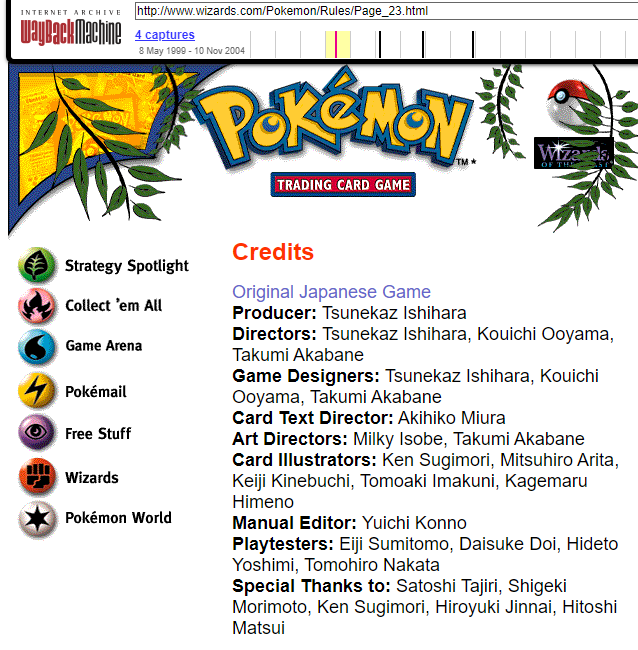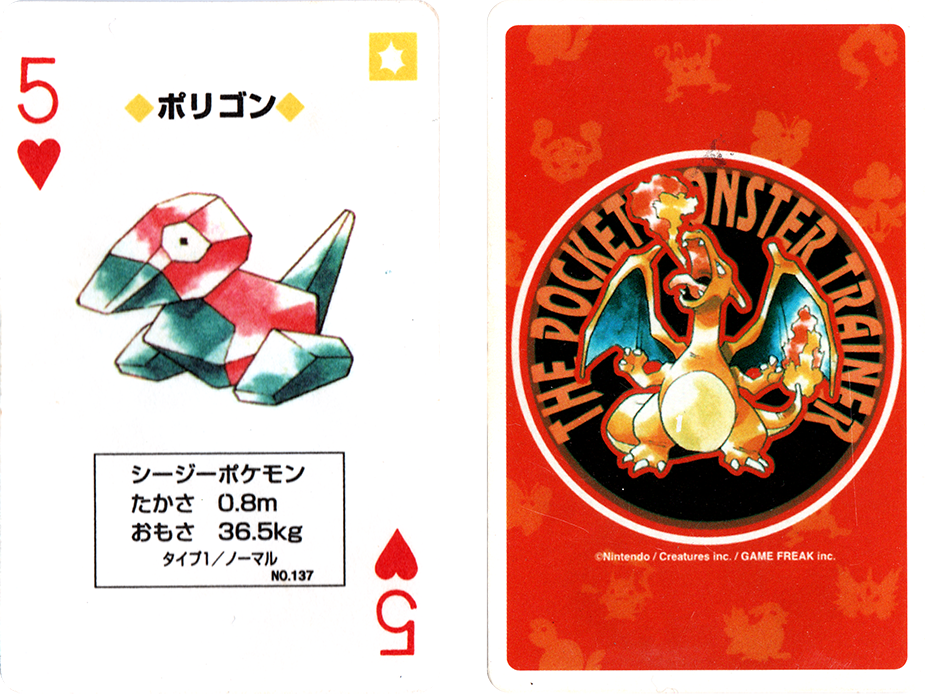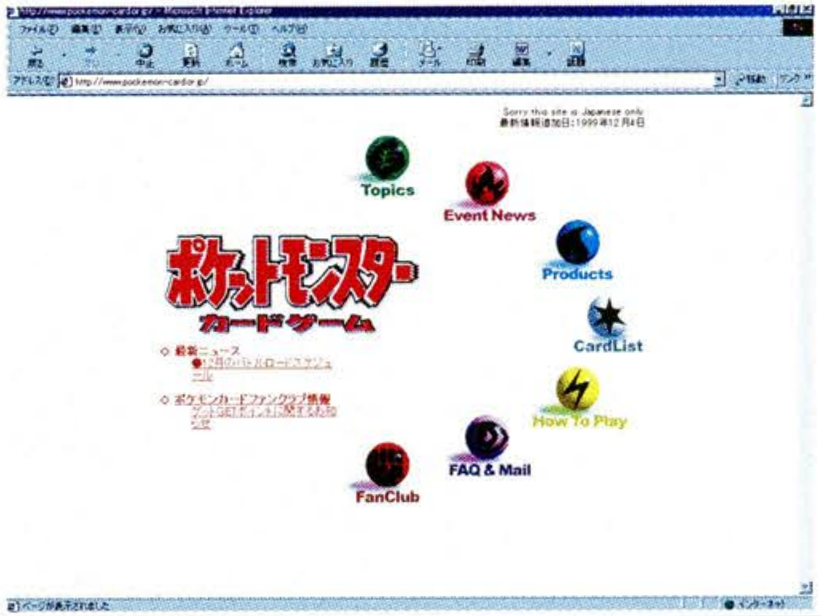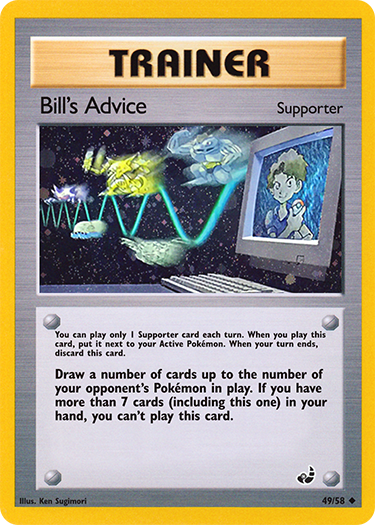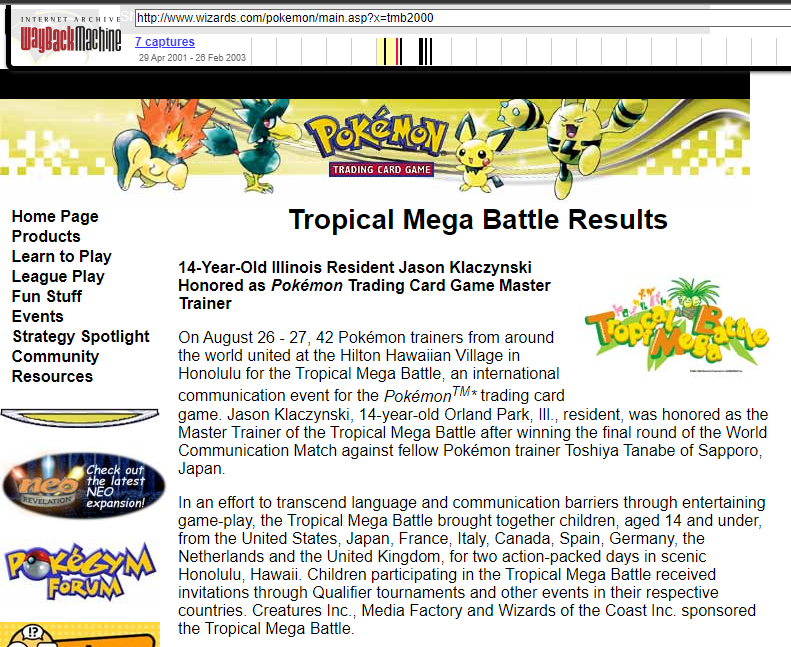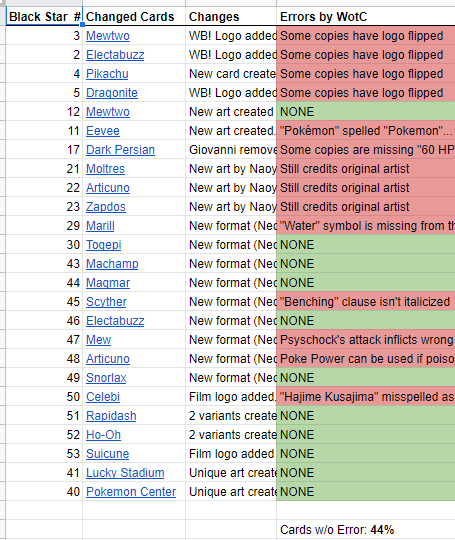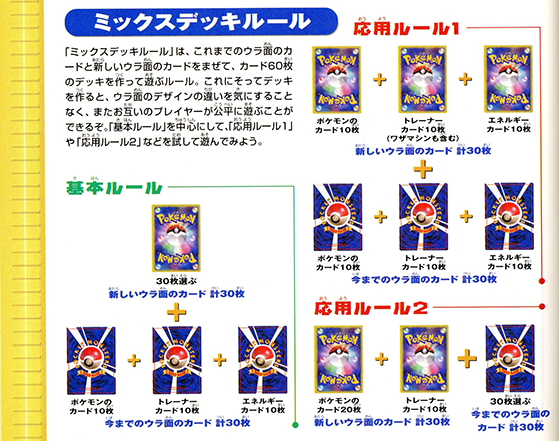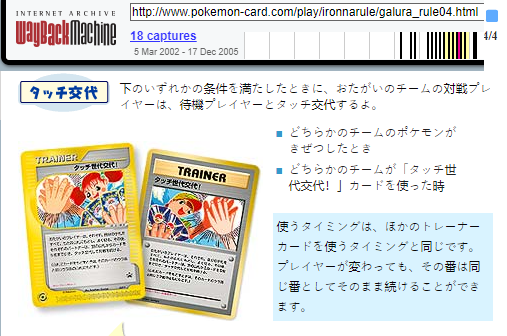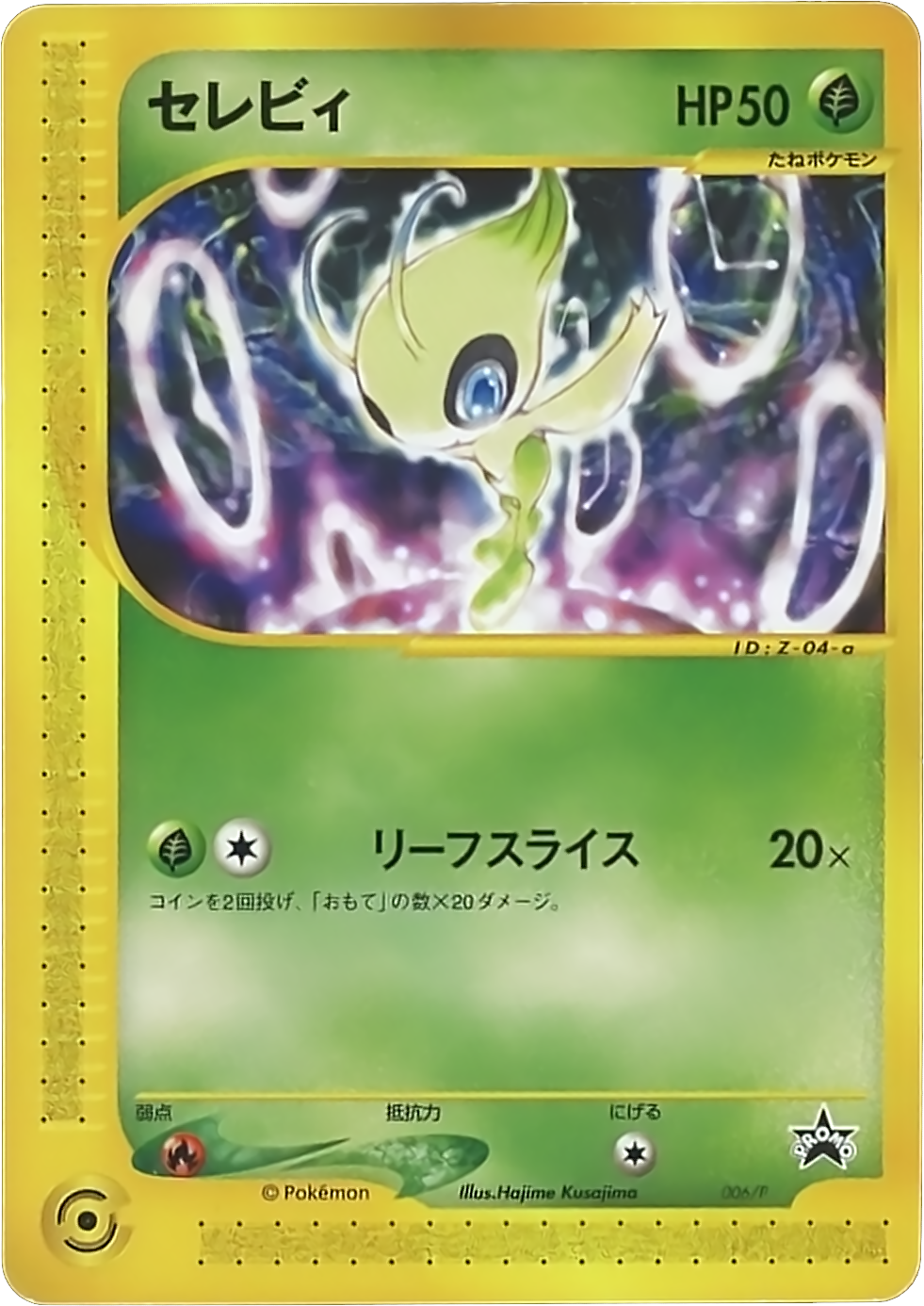
Pokémon Jamboree
The lost 14th base set of Pokémon Trading Cards, from 2003.
By Matt Matoba
Posted 27 June 2022 11:35 PM
Update #1 [1 July 2:08PM]: Sections 1 and 2 swapped for flow, some personal details removed on request.
Update #2 [8 August 6:25PM]: A small update to the story. The Jamboree set I received are now residing with Pure Joy Toys, where they will be safely stored and maintained.
Update #3 [10 April 2023]: Video version created and added.
Sections:
INTRO: Sorry sir, what’s this “Jamboree” business?
The themes of Jamboree
Jamboree’s cards
2a. Wizards liked Lightning type
2b. Wizards heart Imakuni
2c. How much of Jamboree was finished?
2d. “Jamboree” was a beta name
2e. Jamboree’s (intended) release date
2f. Jamboree Products
Nintendo used Jamboree
Why was Jamboree cancelled?
Why did Nintendo want to reclaim the license?
5a. A less than brief timeline
5b. Iwata and respecting the brand
5c. Wizards Learns It’s Over: The Infamous Sheet
5d. Wizards’ endgame: “Scorched Earth Mode”
How in the why did I get to interview these people?
+ other loose thoughts.Glossary + Timeline
Resources:
This article involves information from several new interviews I conducted with:
Mike Boozer
“DMTM” “Dark Master Trainer Mike”
Head of WotC R&D
Mike GIlls
”MTM” “Master Trainer Mike”
WotC R&D
Patrick Swift
”Master Trainer Pat”
WotC R&D
Philippe Van Lieu
“Nick15”
WotC WizPoG Admin, Artist, PA! Mod
Peter Whitley
”The only one without a nickname”
Senior Designer on WotC’s magazine, “The Duelist"
This article also made heavy use of these resources:
Drunk Shuckle’s excellent video on Jamboree.
Wayback Machine, a website that archives old sites, especially those of the early 2000’s.
Mike Boozer, Mike Gills, and Patrick Swift were all R&D testers on Jamboree, and were widely publicly known as the people at Wizards whose job it was to deal with fans. Here on the right all 3 are pictured, via Wizards.com via Wayback Machine.
Following that, here is an audio clip of Mike Boozer commenting that he and the other Mikes were on the Jamboree team.
The 4th person I interviewed, Nick15, was hired by Wizards of the Coast to manage their “WizPoG” Pokémon card forum. Through this he was privy to Jamboree internal information. Here’s Boozer again, the head of R&D, saying as much:
The final interview was with Peter Whitley, who was the Senior Designer on Wizards’ own magazine, The Duelist. As such, he was a member of Wizards’ inside staff, speaking with Media Factory directly.
I recorded all the voice interviews over my crappy old generation iPhone during brief stints of free time and sanity during the Covid lockdown. Throughout this article I’ve highlighted key portions of our interviews where relevant.
Also, I interviewed the head of organized play but I also had to move and lost my phone with the only recording, so that interview won’t referenced. (Fuck and dammit.)
INTRO: Sorry sir, what’s this “Jamboree” business?
Have you ever sat awake and wondered? Why do we call them black holes when we insist we can’t see them? Black is a color. Let’s call them null voids, or perhaps gazmo shafts.
Why do birds suddenly appear? Why do we call them storks? Oh, because they store things.
Who does Marvel think it’s kidding with those cameos? Sam Raimi has become the king of producing superhero movies despite characters jammed in by the studio last second.
Why does the word “Pokémon” have that accent mark that’s so annoying to type? Is that so we’d all pronounce it right? But everyone pronounces it differently anyway, which I completely hate. Yo-Kai Watch did the same thing. We don’t need an accent mark, man, we all know how to pronounce Thor’s hammer.
Pokémon cards nowadays are way different from the Pokémon cards back then, but why? Well, I looked into it, and it’s because now Nintendo makes the cards, but they didn’t use to. So then I wondered who used to, and the answer is Wizards of the Coast in America and Media Factory in Japan.
Media Factory handled the creation. That means making the rules, the art, the templates, and the rest. Wizards came into the picture a few years later, and handled the Western production. That means they would translate and localize stuff. (That ranges from literally translating text to more creative “a rice ball is now a donut” level antics.)
Did Wizards make new cards? Almost never, it seems. Did they make new sets? Again, the answer is no, not really.
Alright, but here’s the most interesting part. In 2003, Wizards lost the license to the card game, and they saw it coming. But that license had earned big enough bonuses to pay off mortgages. So what was Wizards’ response? Well, they wanted to do something big. They were going to go down swinging. They were going to release their first original set of Pokémon cards.
So in 2003, Wizards officially announced their final set, Jamboree. However, something soured behind the scenes, and as history shows, Nintendo didn’t allow its release. This video by Drunk Shuckle is an excellent primer on everything we knew about Jamboree up until now.
So what cards were in Jamboree? What’s a Wizards’ original look like? Was it creamy and brown like a Werther’s Original? I doubt it, but I had to know. And since it was Covid and all that, I had the time.
So, I began researching Jamboree using various connections which included shady people in trench coats. (I’m just joking. What I met with was two Mime Jr.’s in a Galarian Cape.)
Let me be clear, upfront. Most of Jamboree still remains a mystery. However, through several new interviews I conducted with former Wizards staff, I was able to learn some never before heard info about Jamboree, and about the events that led to it. new info about Jamboree.
So the general run down! Let’s start there.
PTCG Credits, via Wizards.com
1. The themes of Jamboree
Wizards of the Coast didn’t make the Pokémon TCG, and neither did Nintendo, and neither did your Duncle who worked at Nintendo. Like, of course those companies all made Pokémon, legally. But if you don’t know this yet, Jimmy John isn’t the one cutting your sandwiches, and Mario isn'’t the one printing your cards.
When Nintendo was getting ready to release Pokémon Red and Green, they wanted to promote with cards. They weren’t able to get a TCG ready in time, so Nintendo first released two poker decks to promote the games.
Still, Nintendo hired Media Factory to produce a promotional, albeit slightly delayed, TCG.
What Media Factory then created was the finished Pokémon TCG, the main one we think of today. Its mechanics were derived from the video game, but to be clear, it was its own unique thing, created by Kouichi Ooyama and other Media Factory staffers. And they made the whole shabbang.
I mean, wow, look how pretty Japanese Base Set packs and boxes looked.
3 years laters in 1999, Nintendo wanted to release Pokémon to America. However, unlike Japan, in America Wizards literally owned the patent to the very idea of TCGs. Great Arceus, I must be kidding you right? But no, really, they did!
So Nintendo had to partner with Wizards to release Pokémon in America. That’s why you want to start a business relationship, right? Because you have to?
By the time the contract was set to expire in late 2003, the relationship had already grown sour and viscous, like a 7/11 bagged pickle. Nintendo had no remaining desire to deal with Wizards, and the contract reverted back to what would become The Pokemon Company. (Legal battles ensued.)
Seemingly in response to this, in the same message that Wizards announced losing the license, they also officially announced Jamboree... However, for reasons that aren’t totally clear, Nintendo eventually prevented the release of Jamboree. Although it was rumored that the cards were finished, no one has ever publicly seen Jamboree, or even learned what a single one of its cards was.
But then time passed! And now that it’s now, people were willing to talk.
Mike Gills, former R&D on Jamboree, spoke on the set’s contents. Confirming the popular rumors, Gills said the set was planned to have “Vending” cards, strong original cards, and “named” cards, such as Dark monsters and Trainer’s Monsters
There was a mix of named cards (such as Blaine’s XXX or Dark XXX) as well as some Trainers that we wanted to help fix some of the balance issues. There was definitely going to be some of the vending cards promos in that set as well.
-Mike Gills
By the way, the “Vending” series was a popular but unofficial term for a series of Japanese-only Pokémon cards that were released through vending machines. They mostly featured really weird and awesome art, as well as some crazy effects.
The art for Jamboree would’ve included original art by Western artists to compliment Wizards’ original cards. Nick15, well known artist from the Create a Card forums, was approached for art. He confirmed:
oldest remaining version of Media Factory’s Pokémon website.
Following what Gills said, I spoke with his former boss and another R&D tester on Jamboree, Mike Boozer.
Boozer confirmed, saying Jamboree was to be the first “Wizards’ designed” set, containing many completely new cards, as well as many of the promos America has missed out on, especially from Vending.
Peter Whitley, Senior Designer for Wizards’ own The Duelist Magazine, also spoke on the contents of Jamboree, adding some new wrinkles. While reviewing Jamboree cards, he commented that the various development staff also wanted to put previously rejected ideas of theirs into Jamboree. They also wanted to bring over ideas from Wizards’ other TCG, Magic the Gathering. Finally, he confirms what we suspected: they also wanted to make some goofy cards.
2. Jamboree’s cards
Jamboree’s playtest team was composed of Mike Boozer, Mike Gills, Mike Elliott, and Patrick Swift.
(Hey. Neat. I interviewed 3 of those 4. Also, psy the duck? 3/4 of those people were dudes named Mike? This got so confusing when I was researching it. I mean my god, it’d be like if you found out 5 Guys Burgers is actually run by 5 dudes who are all named Guy… like, there’s nothing wrong with it, but the odds, right?)
Boozer still had some of Jamboree’s cards and items from testing, although they were scattered in his belongings, lost in a sea of time and Tupperware. It was a free for all near the end, as he described, and members of R&D were allowed to keep whatever they wanted. However, you age that forward some 20 years, and things get lost. Still, after some scrummaging, Boozer did manage to find some of his old Jamboree goods.
He comes across some of Jamboree’s “playtests.” (But kind sir, what’s a playtest?) Well, lucky for me, Boozer explained.
Wizards would sometimes order entire sheets of Pokémon cards from the printer that had nothing printed on the front. This way, between sticky notes and sharpies, cards could be quickly be scribbled together to create or alter effects during the testing process. This is how Wizards developed Jamboree, and also how Wizards developed other card games like Magic.
Peter Whitely also described these to me.
After explaining what they were, Boozer found and named 3 of the Jamboree playtests. In other words, for the first time ever, here are 3 cards that were developed for Jamboree.
For each of these, Boozer hads 1 “complete” card with all data, and several “incomplete” cards with little more than a title on top.
By the way, if it wasn’t obvious, I’m a collector myself. So, I asked Boozer what we all would…
He gifted me 1 of each incomplete card. (Wow, thanks Boozer!!) This next part took months due to Covid, and the package got lost in the mail twice, but I did eventually receive them. The photo below is of my gifted set.
Boozer signed the Bill’s Advice with his old Admin name, “DMTM,” and a quick sketch of his favorite ‘mon, Gengar.
Short tangent, but after I received the playtests and was able to get a good look at them, I couldn’t help but wonder what they’d look like if finished by Wizards. So here’s a mockup of how these 3 Jamboree cards might’ve looked if Wizards was able to release them as planned.
Art from Lt.Surge’s Joteon (CoroCoro promo.) Outdated long before it could be brought over, meta gameplay wise, perhaps this was re-purposed into Jamboree. Further, Boozer openly admitted Wizards was not allowed to reprint Gym Hero cards. (Reason unknown, but proof right here.)
Bill’s Advice. This promo art belonged to a physical mail in campaign, but the campaign has ended. What then for the card? Death and dookies? No, instead it became Bill’s advice, the trainer most associated with PCs and that campaign.
Art from TM Whirlwind. Illustrated by the large personality “Big Mama” Tagawa. The art originally was used on a film promo that America missed, and was a rare promo TM.
Besides the logic mentioned beneath it, the other reason I feel that the Lt. Surge CoroCoro art would be used for Jolteon was this interesting tidbit:
Basically, that’s Gills, back in ‘the day,’ confirming that Wizards wasn’t allowed to reprint Gym Hero cards, which Lt. Surge’s Jolteon belonged to. However, they were allowed to use the cards if Wizards reworked them, such as into a promo.
Alright, back to the interviews.
When I asked Patrick Swift about these particular Jamboree cards, he elaborated. He explained that Bill’s Advice is, in fact, named after that Bill from Pokémon, but also an unlikely second source.
As for the cards’ effect, Boozer couldn’t remember. However, when presented with “Steven’s Advice,” a card printed by Nintendo shortly after Jamboree’s cancellation, Boozer felt strongly it was the same effect as the one he had created. Besides memory, this was due to the hand size clause in Steven’s Advice, which resembles a common Magic the Gathering-type clause.
As for the format and program that Jamboree’s data was designed in- that would be FIlemaker Pro, as Peter Whitley recalled.
(Filemaker Pro is not an image making program. It is a database program, like Excel. However, sometimes print outs from Filemaker would be glued to playtests to create quick test cards.)
While on the subject of Jamboree’s cards, there was also one idea for a Jamboree card mentioned in Wizards’ old chat logs. When Wizards still owned the license, they frequently had R&D, who started as customer service, do live chats with fans on various Pokémon forums. Many of these chats have been entirely preserved, not just through “Wayback Machine,” but also on Wizards’ own site.
In the screenshot from Wizards chat below, MTM (Mike Gills) describes a “Master Trainer” card that would have been a fun card, very much like Imakuni? cards in Vending.
Transcribed to modern Poke-lingo, the effect might have read something like:
Flip a coin until you get tired of flipping.
Nothing happens either way.
Other chat logs also describe how Wizards would’ve liked to have an official create-a-card contest, with the entry likely landing in Jamboree. Unlike other art contests Nintendo held, Wizards’ contest would’ve had the entrant designing the whole card, not just the art.
Ah, but let me get back to the interview with Boozer. Since he found several cards, did he remember the others? Did he have a full list of the set somewhere? Boozer said yes! But unfortunately, it was lost to the winds of time, the sands of fate, and the smog of whoops.
Finally, here’s a little speculation: I’d guess that we can figure out what one of the Jamboree promos would have been. The Pokémon “Unown”, released during Gen II, forms the shape of roman letters. At the time of Wizards losing the license, the only Unown they hadn’t released was R. And at that time, Toys “Я” Us just happened to be the preferred spot for Pokémon Leagues, with many promos distributed there. So, it’d make sense that they’d get the “R” Unown.
(Also, is it news to anyone else that there’s actually a unicode “Я”? I know that’s not exactly what it is, but still sorta neat.)
Toys “Я” Us e-Reader promotional giveaway. Toys “Я” Us had a long relationship with Pokémon promos.
2a. Wizards’ liked Lightning type
Now that you’ve seen some Jamboree stuff, you might be wondering… why Jolteon? Well, because Wizards really liked Lighting type. And they felt it was their duty to make it work. Lemme explain!
In April of 2000, Wizards released their first (and unfortunately, only) original card, Dark Raichu, a lightning type. Ncik15 explained that its creation added an additional 3 months to development. It was Wizards’ baby.
Then, in August of 2000, a magical event happened, Tropical Mega Battle. Invite-only in sunny Hawaii, it was a grand tournament consisting of many TCG events, and in particular, the Gym Leader Challenge. This consisted of participants going from station to station battling Media Factory staff. But as you’ve maybe guessed, each station was decorated like a Kanto Gym, and each Gym was filled with staff cosplaying the Gym Leader and Gym Trainers. So then, who should play apparent Vietnam veteran Lt. Surge? Well, the Americans at Wizards, yee-hah!
So Mike Elliott, who would become R&D on Jamboree, was elected to play Surge himself, leader of the Lightning. Boozer, Gils, and others played the Gym’s Trainers.
From this, the staff at Wizards’ love for lightning grew. It was their element. These were their Pokemon. They wanted to prove Lightning was where it was at.
Lightning… was not where it was at. In June 2003, Boozer even commented lightning was still too weak, and that he’d tried to bring in more Lightning type promos.
In this same response, Boozer explains the “Best of Game” set was his decision. Best of Game Hitmonchan, an anti-lightning Fighting type, had it’s HP “accidentally” set too low, at 60 HP instead of 70HP.
So, when it came time to design their own set, Wizards’ was primed and ready to make Lightning shine. And the result, it now seems, was Jolteon.
2b. Wizards Heart Imakuni
Tomoaki Imakuni is often referred to as a popular comedian in Japan at the time of Pokemon’s release, but he was also one of the game’s original illustrators. He created many cards you’re familiar with, such as Base Set Porygon.
He also created many ridiculous cards for Vending, some of which were literally illegal-to-play gag cards. These stood out and really defined the flavor of the Vending series, so they would be likely candidates to be ported into Jamboree. But do we know how Wizards’ felt about Imakuni?
Hell yeah, we totally do. First off, there was literally a “Who is Imakuni?” on Wizards’ official FAQ.
By the way, this whole FAQ is crazy. If you enjoyed reading the leaked version of Michael Bay’s Ninja Turtles, this is like that.
Also, when I interviewed Boozer, he even brought up the time Imakuni gave him a personalized card:
Also, that photo of Imakuni on the right? That was taken by Boozer himself, at the Tropical Mega Battle.
“Master Trainer” Patrick Swift also recounted Boozer’s love of Imakuni’s wildness and abandon:
So, very likely, Imakuni was to be featured prominently in Jamboree. Also, there’s a whole 2nd half to Wizards’ liking Imakuni, but that’s in the Jamboree’s title section lower. Wow this is kinda long already.
(If you’re interested, here’s a list of Imakuni cards unreleased by Wizards. It’s under the Imakuni tab.)
(I didn’t, however, get it from Boozer. I dug it up from Boozer’s old fan site, which was hosted on Wizards.com…. It’s a lot. It’s really a lot. Here it is in its Web 1.0 glory. I know you’ll want to look. We all want to look when someone barfs, even though no one wants to see chunks. Anyway, yeah, here’s that.)
self depiction,
by Imakuni?
2c. How much of Jamboree was finished?
When asked this question, Mike Gills, former R&D on Jamboree, remarkulated:
“We did complete the set and there was some initial logo work and cover art as well.”
Going off industry patterns in the PTCG, that probably means the presentation materials were finished for Jamboree. This would’ve been the package of contents that Wizards presented to Nintendo for final permissions before printing. So, these materials should be relatively far along, but not completely final.
Generally, these packets include a logo, merchandise ideas (such as theme deck ideas), and at least some cards with artwork prepared so that Nintendo could get a proper idea of the set’s visuals.
(That said, “final” art might not have been original art. It could’ve been, for example, art from a card that wasn’t released in America, re-purposed into a new template for Jamboree, as my Lt. Surge’s Jolteon theory suggests in a few sections.)
2d. “Jamboree” was a beta name.
Turns out, “Jamboree” wasn’t even going to be the set’s final name. Boozer confirmed that it was only a beta name, likely to be changed later, as per usual practice.
So then what would the final name have been?
1) First off, perhaps it would’ve remained “Jamboree”, as even Boozer admits that beta names sometimes stuck.
2) Perslaps “Vending” would have been the final name. Remember that Vending is an invented term, never officially used. The true name of that set is simply “Expansion Sheet”. However, Wizards often used the term “Vending” to describe that set and its cards. And don’t forget- Wizards felt this was their game. If Wizards then chose to finalize Jamboree as “Vending,” truly, they would have created the “Vending” set.
“…and a vending-machine Pikachu promo…”
from Wizards.com, via Wayback Machine
3) If not Vending, perhaps “Akimbo” would’ve been the final set name. For reasons not completely clear to me (although I sense it stems from a sense of 90’s randomness) Boozer loves the word Akimbo. He wrote an official Pokémon musing column for Wizards named “Akimbo,” and goes as far as to mention introducing the word “akimbo” in his wizard.com bio.
Wizards even made sure to even define Akimbo in the Wizards’ FAQ, where he remarks it’s a term describing the flailed state of one’s limbs during extreme motion. (Think Elaine’s dance in Seinfeld.)
Since “Jamboree” means a wild fun party, with limbs all akimbo, it’d be a fitting name. The word “Akimbo” also perfectly describes Imakuni?’s antennae. Since Boozer loves Imakuni?, and many of the missing Vending cards were by Imakuni?, it’s likely Imakuni?, and his flailing style, were going to be featured in Jamboree.
2e. Jamboree’s (intended) release date
Even back then, Wizards was clear that Jamboree’s release date was unclear.
However, since Jamboree was announced when Wizards learned they’d lose the license, and was to be printed before they lost the license, its intended release date had to fall between March through August of 2003.
This in mind, since it was to be the last set released by Wizards, its likely release date was August 2003.
2f. Jamboree products
Boozer confirmed that packaging had indeed been produced. Unfortunately, catching up to now, he has lost or given away all of it.
Gills explained that he had already finished designing several theme decks for Jamboree, though this is not new information.
Boozer couldn’t remember the contents of the decks, and since he relinquished all copies, their current lists are still unknown.
3. Nintendo used Jamboree
To me, the most interesting thing to come from the interviews was sounds and noise which I understood to be words.
And to me, the most interesting part of those words was when Mike Boozer. former R&D and Jamboree playtester, said Nintendo took the contents of Jamboree and secretly released them later under a different set name.
When I asked if Jamboree was the entirety of the next set, Boozer clarified that it was used to fill out a Nintendo set, which already had some other cards.
He points out that it was Nintendo’s right to do so, by all means. But also, he clearly felt it was a dick move.
Patrick Swift, Boozer’s former co-worker in playtesting Jamboree, also remembered his feelings at learning Jamboree had been re-purposed.
When I asked Boozer if he remembered the set that Jamboree was ultimately released in, he didn’t immediately remember the name. But he remembered the feeling.
Luckily, it is now currently 2020 or whatever and cell phones are magic. So Boozer and I paused to go to Bulbapedia.
I started by listing off the names of sets that came immediately after Wizards’ final released set. It didn’t take us long.
Oh! EX Sandstorm! That weird one??
So look, here’s how it usually works. Japan will get a pack of Pokémon cards first. Then, after a few months are spent on translating it and printing it, America would get that pack of cards.
However, when EX Sandstorm released in America, there were 47 brand new cards in it that hadn’t been seen anywhere else in the world.
Not only is that weird on its own, but EX Sandstorm was meant to be a “Gen III” pack, a Ruby & Sapphire era pack. That means the Pokémon it contains should be sourced from the Ruby & Sapphire video games. However, about half of those 47 brand new cards cards were Gen I and Gen II Pokémon, who are wholly unrelated to Gen III. So, like, dang man. Really feels out of place.
And guess what… in those 47 cards, in EX Sandstorm, there is a Jolteon. From this, and from Boozer identifying EX Sandstorm, perhaps we can deduce that these 47 new cards in EX Sandstorm are, in fact, the missing Jamboree cards.
So then, perhaps this list of those 47 cards is a list of the “ported” Jamboree cards.
That said, we can clearly see that the Jolteon released in EX Sandstorm and the Jamboree Jolteon are totally different. I asked Boozer about this, and he responded:
From Boozer’s comments, if that’s the case, we can’t be sure whether each individual card retains its effects from Wizards’ design or has new, Nintendo created effects.
There are also Pokémon in those 47 cards who are from Gen III, and it’s known that Wizards hadn’t seen the various Gen III Pokémon. So then, where were these cards from? Perhaps they were Gen I or II monsters that Nintendo converted after porting. Or, perhaps they came from a yet still unknown third source. Until someone from TPCi speaks on this, we can’t know. When I reached out to a current TPCi employee who also worked at WotC during the early Pokémon days, they expressed that they didn’t remember the origin source of the 47 cards, and said that most cards are sourced from Japanese sets. However, these certainly were not.
Having said all that, Jamboree was only partly to be composed of Wizards’ originals. The rest of its cards were to be promos that Japan had received but Wizards hadn’t distributed yet. So, I was curious what that could include.
Here’s a list of the rest of the promos Wizards didn’t distribute. It is a whole lot. This list only accounts for unique promos, so if something was distributed twice I only listed it once. Also, Wizards had a history of rejecting cards with very similar art, such as the Black Star Mewtwo and Christopher Rush situation. So, cards that used exactly the same Ken Sugimori key art were also not included on this list.
4. Why was Jamboree cancelled?
At one point, Wizards felt confident enough about Jamboree to announce its release to the public. (See image on right by Gills himself.) However, as we now know, it would never be released. So what happened?
When asked this question, the various Wizards affiliated developers explained what they felt was the answer. They felt that Wizards had overstepped its bounds by attempting to create so many original cards, and it rubbed Nintendo the wrong way. Mike Gills explained:
The Pokémon company did not want us creating cards, just to translate and support the ones they created. We were too successful with the Pokémon TCG.... As the TCG grew in popularity, it became how many new players first learned about Pokémon and I don’t think Nintendo wanted the global TCG and its organized play and leagues to get more press than the video games. I believe this is also why the license was not renewed and the current Pokémon Company International was formed with many ex-WoTC employees...
-Mike Gills
However, articles written at the time paint a slightly clearer picture. The Seattle Puget Sound Business Journal and others asserted that Nintendo was willing to allow Wizards to release Jamboree, but only if, in return, Wizards would share industry secrets with them.
In the end, Wizards wouldn’t release the secrets, and so Nintendo locked Jamboree away.
However, I think the truth lies yet further, in a slightly larger third version of events.
I think the above is clearly the truth, however, I want to know how these two companies ended up at that offer of compromise. I think it had much less to do with Jamboree itself, and everything to do with consolidating Pokémon into one entity, and cutting off a rogue limb that wouldn’t play ball.
5. Why did Nintendo want to reclaim the license?
5a. A less than brief timeline
Jamboree, and this whole Nintendo-Wizards relationship, fell apart when Wizards lost the license. So then, why did Nintendo let Wizards have the license in the first place? Especially when the license was worth somewhere near $100M just the year before? (See chart on right.)
Well, because Wizards of the Coast literally had the patent to Trading Card Games.
In fact, Wizards’ own former Sales Director straight out says "...the patent... that was one of the things that made the folks in Japan think that we would be the ones."
(7:02 until 7:29)
Right out the gate, this created a situation where Nintendo was unhappy. They only wanted a custodian to the product, whereas Wizards wanted to actually create. Nick15 described how Wizards just did not understand the assignment:
Wizards publicly expressed that they felt it was their duty to craft a true game out of what they felt was only a collectible. This sentiment was extremely common among both players and developers at the time.
Soon, however, game errors caused by Wizards arose, such as this one, noted by a fan way back in August 1999.
Wizards had been hired to produce the cards, only. That means translating and inputting data. However, it became increasingly common that if Wizards altered a card, an error was introduced.
Take, for example, the “Black Star” promo, Dark Persian. After Wizards forgot to turn on a layer in Photoshop, the card was printed without any HP, causing a several month delay.
But what’s a “Black Star” promo, you ask? Well shuckles, lemme tell ya. The “main” promo cards were known as Black Star promos, due to the little black star icon they had.
If you look at the total list of Wizards’ Black Star promos, and then cut it down to a list of only the cards that Wizards introduced changes to, something interesting happens. Viewing this list of only altered cards, you can see that Wizards’ success rate was, not joking, 44%.
Mostly wrong.
Despite this, in April of 2000, Wizards finally received permission to make a wholly original card. The end product was “Dark Raichu” in the Team Rocket set, but its creation delayed the American release by 3 months, an eternity by card game standards. Nick15 described the situation:
Then, after all this friction, after learning they would lose the license, Wizards announced their own set, Jamboree.
Nintendo was not enthused.
In the eyes of Nintendo, Wizards’ continual treatment of the game as a commodity instead of a service, along with their unwillingness to cooperate with Nintendo’s plans had made them untenable business partners. It was time for the license to come home.
Whereas Nintendo gave everything a 10/10 performance, Wizards followed a nine/ten-do. Heh heh horf horf.
5b. Iwata and respecting the brand
The height of Wizards’ relationship issues with Nintendo was during those final years, 2000-2003. This time period is also when Satoru Iwata joined Nintendo and rose to President.
Bringing up Iwata may seem out of left field, but the notion originally came from Peter Whitley. He commented the whole license fight had mostly been between the higher ups, which would’ve been Vince Calouri at Wizards and Satoru Iwata at Nintendo.
Having said that, Iwata isn’t typically associated with the Pokémon TCG, though he is associated with Pokémon. Let me explain the circumstances surrounding Nintendo at the time, and more importantly, please allow me to explain the way Iwata liked to do business.
The recently published memoir “Ask Iwata” opens with the story of the difficult decisions it took for Iwata to save HAL Laboratory, where he was President before his time at Nintendo. The first order of business to save HAL was to keep control over their licenses, so they needed to create their own game. Iwata cancelled all current projects to instead focus on a completely original IP. This project eventually became Kirby, the pink puff who pulled HAL out of debt. (Poiyo.)
Then, in 2000, during the famously difficult GameCube years, Iwata joined Nintendo, a company that was financially suffering. And so again, it seems his first move was to bring the licenses in house.
Echoing this sentiment, Peter Whitley said that Nintendo felt they had given away too much in the initial agreement, which Iwata had not been a part of.
The person who had been in charge of those initial agreements, where the license was sold, was Tsunekazu Ishihara.
Here, on the right, in an Iwata Asks segment, Ishihara seems to describe that even he felt he was too loose with the various Pokémon licenses, highlighting the trading card game specifically.
In the next section of that same Iwata Asks segment, shown below, Ishihara knew it was important to control the various Pokémon licenses, but felt that they had been distributed too far and wide, making consolidating them a nigh impossible task. However, Iwata was up to it. He formed The Pokémon Company, whose main focus was organization and management of Pokémon’s many licenses, and appointed Ishihara as CEO.
This wasn’t the first time Iwata had helped Pokémon, or even Ishihara specifically.
In 1995, for the release of the original Pokémon video games, Iwata helped establish Creatures, placing Ishihara in the lead.
Then, when facing coding difficulties before the release of Pokémon Gen II, Iwata was brought in, ultimately optimizing the code to such an extent there was enough room to fit a version of Gen I onto Gen II’s game cartridge.
In 2002, when Iwata became President of Nintendo, the Pokémon TCG was experiencing its first major sales decline. This was the results of many factors, but one which must be considered was that Wizards had artificially inflated the market. Here’s a rundown of how:
Early Creatures logo
Updated Creatures logo
(I’m not kidding! It literally says “What you gonna do”. Wow.)
“Oh, this is horrible. We hate this game.”
-Wizards CEO seeing PTCG for first time.
At the launch of the PTCG in Japan, packs were priced at $3 for 10 cards, with exactly 1 holo.
At the launch of the PTCG in America, packs were priced at $3 for 10 cards, with about 1 holo per 3 packs. Notice the “about” and 1 per 3.
Peter Whitley spoke on this, describing how Wizards saw Pokémon as a 2nd go at Magic the Gathering, where they could squeeze the margins everywhere.
For collectors, packs without a holo are so worthless they’re called a “miss.” Here, you can see just how low players and Wizards alike valued the common cards.
Remember, if you get 1 holo in 3 packs of 11 cards, then 32/33 cards, or 96.9% of what you paid for, was commons.
So, to receive a holo in Japanese, you know you only have to pay $3. However, to receive one in English, you’d have to get a little lucky, and you’d expect to pay $9. Already, things were 3x worse.
Then, Wizards began raising prices, increasing the price of a pack from $2.99 to $3.29. Fans note that a pack of 11 Pokemon cards now costs $3.29, while a pack of 15 of Wizards’ own Magic the Gathering cards costs just $3.
Confronted by this, Wizards says the price is due to licensing fees from Nintendo that cause the cards to cost much more. However, according to Peter Whitley, the truth was that Wizards was pocketing the money:
Here, a player uses hyperbole, asking why packs are so expensive when they contain a few cents of product:
When presented with this response, Peter Whitley felt very different…
And after all that, what happens when you did collect them all? Didn’t Wizards deserve more of your money? But of course, so they invented something new- multiple card versions.
Wizards even began selling above their own MSRP in their online store.
Again, fans took notice.
Whitley even described that the price codex in the back of The Duelist was one of many various internal mechanisms to remind people that these things were commodities.
Peter Adkison, CEO of Wizards, upon seeing the Pokémon TCG for the first time.
from “SO DO YOU WEAR A CAPE,” available to view on Google Books via this link right here.
“…think of Pokemon like checkers and Magic like chess (but with more pieces).” -Wizards.com FAQ
So, while Nintendo was experiencing financial drain, Wizards… was not. Check out how Wizards’ own former CEO describes the situation on his LinkedIn bio:
I mean, look, it’s pretty easy to get. Have you ever gone to buy a pack of Pokémon, only to find it’s all sold out? And then when you do finally find a pack, its price is all jacked up by some scalper who didn’t do anything except get to the store before you did, and suddenly it costs 6 times the same amount to get the same thing? Sucks, right? Well, yeah… that’s what Wizards did.
But getting back to Nintendo’s response. Despite all this, I think Iwata still tried to create a unified Pokémon game.
At E3 2002, Nintendo’s booth featured a preview of their new Gameboy peripheral, the e-Reader. In addition, there were Pokémon e-Reader cards for testing. However, these cards featured a brand new back, different from either the current American or Japanese backs.
Pokémon Play leagues are separated in America and Japan due to issues such as the Pokémon cards having different backs. So, here, I think Iwata was attempting to create a new, worldwide back, joining the leagues. As a polite compromise, the new backs even used the American logo, not the Japanese one.
Fans were quick to notice, flocking to message boards, including Wizards’ own WizPoG forum. Some speculated that the cards were fakes. Nick15, however, quickly deduced the truth: these cards were real, but were printed by Nintendo with what would become the new Japanese backs. However, opinions on the backs quickly soured:
Finally, Gills joined in, proudly saying they’d talked Nintendo out of it.
I think what they really talked Nintendo out of was the hope of unification. I mean, it’s really not a hard fix. Pokémon cards rotate out of being playable with seasons, anyway, so just put the cards in sleeves, once.
Not only did a fan at the time arrive at this same conclusion,
but this is, in fact, what Nintendo eventually did with their Neo Generation Change tournament in Japan.
PCGP: Perhaps created by Iwata in hopes of a unified community?
PCGP Player Updates
PCGP player website
PCGP player website
Mixed Deck Rules
from Pokémon Trainer Mag #13, pg 31
Anyway, let’s look at it from Iwata’s point of view. You’ve just introduced a whole new era to the cards, the e-Reader era, and you are, apparently, completely reliant on 1 American printing studio to get it done.
And now, your business partner has completely refused your proposition of unification.
Whatever the reason was, Iwata found himself desiring to regain the license, which would mean no longer working with Wizards. But if that was the case, Nintendo would need to see if they could still print the cards with that certain special printer, but without Wizards.
And I think that’s why this next thing happened.
5c. Wizards Learns It’s Over: The Infamous Sheet
Patrick Swift revealed the never-before known moment that Wizards learned they would lose the license, corroborated by Boozer.
Wizards used PBM Graphics to print the cards. Sometimes, PBM sent uncut sheets of cards to Wizards to be previewed.
One day, Boozer opened a sheet of uncut e-Reader cards. However, Wizards hadn’t ordered the sheet. Wizards hadn’t even seen this Pokémon.
Let’s take a mini-research tangent and see which card Pat may have been talking about. Most likely, it was this Celebi to the right. (Scanned from my own collection, thank ya!) This Celebi is “Leaf” type, as Pat mentioned, but the name of its attack is also literally “Leaf Slice.” This particular card was the 2nd e-Reader promo physically released, and was distributed at Nintendo’s own Space World convention. For that, they’d need new promos, and for that, they’d need Wizards’ friend, PBM Graphics. This is also one of the first P Promos, which were Nintendo’s first line of numbered promo cards, and which borrowed the Black Star that Wizards invented.
There is also a P Promo Treecko, but due to timing, Celebi’s the stronger candidate. For one thing, the year Nintendo introduced the e-Reader at E3, for some bizarre reason, they sent this promotional art package to various news outlets:
Even though this was for the American audience, notice how it uses the Japanese version of the Celebi card to demo the e-Reader. In fact, even Wizards.com used a version of this exact art, with the Japanese Celebi included. (Image on right.)
Perhaps this was also what killed “e-Reader era” Pokemon cards. Those were heavily associated with Wizards. Seemingly, only Wizards’ printer, in America, could make them. Even Media Factory, when listing sets on the homepage, used Wizards’ branding on e-Reader era cards.
Notice how the e-Reader set, alone, uses the American blue and yellow logo.
Then, as soon as Wizards lost the license, e-Reader cards were ended everywhere but America. Not the West, mind you- they only continued in America. All other cards, such as Japanese or Spanish, were no longer printed in e-Reader format. American cards continued to be in e-Reader format, but no longer had the long side code that allowed them to contain most of their data. And with that loss of storage space, all the cards also lost any new or custom applications. Whereas they used to have upwards of entire mini games via their side codes, the new American-only ones had simple Pokedex entries.
Hey look, it’s the new backs again!
But back to Wizards’ reaction.
Panic. Shock. Losing this license would not be good.
Someone besides Wizards had ordered a full sheet of Pokémon cards using real templates and from the real printer, but with new art and new Pokémon. And, the due date for license renewal was upcoming with the release of Gen III. It was immediately clear- mostly likely, Nintendo had ordered these, to see if they could produce the cards without Wizards. So now you gotta be wondering, what was Wizards’ response to learning they were about to loose their golden goose?
5d. Wizards’ endgame: “Scorched Earth Mode”
Wizards was ready to burn it to the ground. If Pokémon couldn’t work for them, then Wizards wouldn’t let it work for anyone. Multiple employees describe a “Scorched Earth Mode” that was placed in effect by Vince Calouri, VP of WIzards.
Wizards decided to vent the entire supply of a private stocked warehouse, specifically to crang out Pokémon's economy via principles of supply and demand. Pat describes,
Pat added that Organized Play was no longer interested in putting in any effort.
In practice, that sometimes rocked for the consumer, such as when Organized Play ran “Fan Appreciation Tournaments,” or “FAT” events, where entry fee was often $6 and minimum prizing was 16 packs. Maximum prizing? A loose bag of 1000 holos, 200 of which were random.
Other times, goofy tunes like this happened. Check it out. Wizards totally just nerfed a Fighting monster because it was strong and anti-lightning. Just look how often people brought this to Gills’ attention back in the day.
At the time, Nintendo openly said Wizards’ cards were legal.
Wizards, however, maintained that the cards could not be mixed.
“Best of Game” version, 60HP.
Correct version, 70HP.
Wizards’ original creation, weak to fighting, and with only 70HP itself.
And after all this, what was the outcome? Wizards lost respect, and their behavior drove some fans to other games.
6. How in the why did I get to interview these people?
Fuck, no reason man. It’s 2019. Or it’s 2022 or something. Holy shit, I don’t remember anymore. Do you? Does anyone? Can Covid please end?
Did you think “lucky!” when you saw the playtests I got? Well I am, shit! But also, actually getting them was fucking terrible. The dickshit delivery guy busted a man-fist sized hole in the box, so he elected to leave it in his truck. He told me this as he crested the curb towards my mailbox, then had me go wait for him at his truck. (Yes, this is all weird. He was weird. This was USPS. What the hell has happened to people.) I waited for like 20 minutes, then he finally returned to his truck. (I wasn’t the last person on his route, and he insisted on finishing it first. Which, like, of course. But just bring the damn package. Or I don’t know. But who the hell wants to wait outside a USPS truck at 7PM on some damn Tuesday?) Then the guy gives me this ragged thing that looks like the plush bunny at the end of Con Air and he literally tells me, “Does it look like it’s all there?” Well how the fuck do I know if it’s all there? And based on the grunk hole he’s just showed me, it most likely isn’t all there! Holy Shit! (Luckily, Boozer later confirmed it was all there. I didn’t know exact package contents in advance.)
Anyway, why did I get to do this? No reason. Anyone can try. I like to research and, luckily for me, I’m good at it. I spoke with Nick15 first. He helped me get in touch with TPCi. That led me to another Wizards employee. That guy lead me to a guy, who led me a guy, who led me to a guy, and finally, Mike Boozer.
I am not professionally related to any of these events or people, but I have enjoyed Pokémon cards since Kuma sold me base pack, smuggled tax free, at Yaohan Plaza in ‘97 or so. No import fees either! Again, cuz he smuggled it in. Good guy. He busted packs and sold singles at reasonable rates, plus had a fair and open purchase chart. He’d pay crazy top dollar for cards that he personally wanted, or for cards that he needed to complete a set for the shop. Memories like these are probably a lot of why so many of the people I interviewed opened up- they loved those days too. And everyone loves thinking about the good ol’ days.
I hope this was interesting. I’d certainly rather it was. But I’m not gonna shout louder or fabricate facts if it wasn’t. Lemme know if you want to trade cards, by the way. I have 3 pre-release Gyarados and no pre-release Clefables. C’mon man.
Update: A small update to the story. The Jamboree set I received are now residing with Pure Joy Toys, where they will be safely stored and maintained.
Boozer and un-identified cigar demolishing co-worker. via Wizards.com
This one’s fun. Boozer talks about the Pre-release Raichu, another Pokémon relic.
This one’s fun too. Boozer realizes he vastly undersold his Skyridge collection. I mean, I’m not happy it happened, but it’s a fun clip.
Ah, this one’s a good sound byte. It’d make a nice clip intro for the whole article, I think.
Here’s a neat thing. When I asked Gills If you could make any card, what would it be?, he responded with:
I still have the “Mike’s Weedle” card that my friends at Team Zeo created for me (plus the cool Weedle counter bag, the homemade Weedle pins, and plenty of other fan made promos).
(original image on right)
-Mike Gills
It’s a fan made fake that he had commissioned, and then passed around the office, “Mike’s Weedle.” Considering Gills had just explained that he’d like “named cards,” this is perhaps the sort of thing he invisioned. Of note; although many Jamboree cards would likely be goofy with semi-impossible effects, the full Wizards’ original cards would likely have been “competitive” cards designed for meta play, without goofy effects. But perhaps the various Master Trainer’s were planning to add themselves, much as how there are Imakuni? and Ooyama owned Pokemon.
Original photo from Mike Gills. Note that its ID number is “P1”.
Digital recreation by interviewer.
Also, of peculiar note: The “Space Weedle” was created on or before April 2001, and the first official card called a “P Promo" wasn’t released by Nintendo until July 2001. Perhaps this was shared with Nintendo as a Jamboree pitch? And perhaps the “P” nomenclature stuck.
Left to right: Mike Gills, The Space Weedle, Patrick Swift
As a marketing event, the Master Trainers asked fans to donate Weedles, and the result was the human-sized Space Weedle.
Glossary
Jamboree: The 14th main Pokemon card set from Wizards of the Coast. Cancelled before public release, after Wizards lost the license to the PTCG.
PTCG: Pokemon Trading Card Game. (As opposed to the video game, the anime, or the spicy terrible stage play.)
Nintendo: Famed game company. Producer of Pokemon and the PTCG.
Satoru Iwata: 4th President of Nintendo. The President of Nintendo during which our research takes place. Was famously clever with programming and business.
Iwata Asks: A series of interviews on Nintendo.com, hosted by Satoru Iwata. In the interviews, Iwata invited various game developers to honestly discuss the nature of a project’s development.
Media Factory: The company which originally created the trading card game in 1996. Media Factory was contracted by Nintendo to create a promotional product for the upcoming Pokemon video games.
Tomoaki Imakuni: Staff member at Media Factory. Created many original illustrations and worked on the TCG, and also contributed music and more to other aspects of the Pokemon franchise.
“Imakuni?”: Popular alter ego of Pokemon card designer & illustrator Tomoaki Imakuni.
Kouichi Ooyama: Staff member at Media Factory. Credited by bulbapedia as 1 of the 3 principal creators. Contributed rules, design, art- most of it, though rarely final art, until recently.
Dr. Ooyama: Kouichi’s alter ego, akin to Imakuni? above.
Ken Sugimori: Designer of many of the original 151 Pokémon. Even on Pokémon he didn’t design, he still created most of their original key art, or “stock art.”
WotC: Wizards of the Coast. The American license holders for the Pokemon trading card game, as well as distributors, and sometimes creators.
Magic: MtG, or Magic the Gathering. Wizards’ own, original card game, which pre-dates the PTCG. Wizards created and produced Magic.
License: The legal contract giving you the ability to sell a product. (Roughly speakin’.)
Master Trainer: A title invented by WotC. Used to describe their admins on their forums, but also used to describe players of a certain level, and sometimes in ads used to refer to any player.
WizPog: Wizards’ PokeGym, or the short nickname for the Wizards owned Pokemon card forum.
Vending Series: Popular but unofficial term for a series of Japanese-only Pokemon cards that were released through vending machines.
R&D: Research and development. The people who come up with the details and rules.
Playtesters: The people who pressure test a build. They play with a thing over and over to see if it needs to be changed or balanced, or scrapped entirely.
TPCi: The Pokemon Company International. The modern incarnate of the Pokemon company, comprising of many of the staff who piloted the companies in the 90’s who held the license. The global side of the current Pokemon organization.
Timeline
1989 - Game Freak founded
1993 - Iwata becomes President of HAL at Nintendo’s “”suggestion””
1994 - Iwata & HAL are asked by Nintendo to help Shigesato Itoi with Mother 2
1995 - Creatures founded by Ishihara with help from Iwata
1996, February 27 - Pokemon Red and Green in Japan
1996, October 20 - Base set cards released in Japanese
1998, April 23 - Pokemon Co founded
1998, September 28 - Pokemon Red and Blue released in US
1999, January 9 - Base set cards released in English
2000 - Iwata joins Nintendo
2000, April - Dark Raichu
2002, August - Media Factory updates their ancient website to a more modern one featuring an online store selling e-reader packs.
2002, May 24 - E3 e-reader cards
2002, May 24 - Legendary collection
2002, May 24 - Iwata is pres of nintendo
2003, April 28 - Wizards announces they lost the license to the PTCG.
2003, April 28 - Wizards announces they’ll release “Jamboree.”
2003, May 12 - Skyridge english
2003, June 18 - EX Ruby Sapphire english
2003, September 18 - EX Sandstorm, English, releases.
2003, October 1- Lawsuit
2004, Jan - Undone Seal, Japanese, releases.






